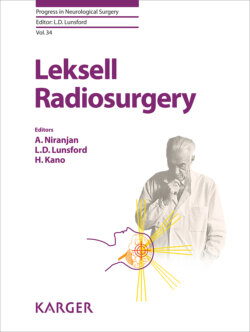Читать книгу Leksell Radiosurgery - Группа авторов - Страница 52
На сайте Литреса книга снята с продажи.
MRI Alone for Radiosurgery Planning
ОглавлениеMRI has been used as a stand-alone modality for SRS treatment planning [1]. Traditionally, 1.5-T MRI scanners have been used for this purpose. There is increasing interest now in the use of 3-T MRI scanners, which have a higher signal to noise ratio and consequently higher spatial resolution and shorter image acquisition time. A recent study by Zhang et al. [2] showed that the geometric accuracy achieved with 3-T MRI is comparable to 1.5-T MRI for SRS treatment planning. 3-T MRI scanning with frame on must be done with the aluminum pins and patients should be screened in advance for 3-T eligibility. The advantage of MRI-based planning is that it removes systematic errors that may occur due to CT-MRI registration and eliminates radiation exposure from the CT scan. However, if using MRI alone, each center must perform rigorous quality assurance of MR images to exclude the possibility of artifacts, including spatial distortion of the MRI scan due to gradient field nonlinearity and magnetic field inhomogeneity. MRI is essential for the majority of indications of SRS. The excellent soft tissue contrast of MRI permits optimal delineation of the visualization of tumor volume and organs at risk. While CT imaging can be safely assumed to be geometrically accurate, with MRI the geometrical accuracy can be compromised by imperfections in the main magnetic field and in the gradient fields, and by the distribution of magnetic susceptibility values within biological tissues and movement-related artifacts. Magnetic field inhomogeneity is known to stem from the static magnetic field inhomogeneity and from the magnetic properties of the scanned object itself (the patient’s head). The magnitude of the MR image distortions is minimal at the center of a closed-bore magnet and increases gradually toward the radial edges of the scanning volume [3]. Schmidt et al. [4] investigated MRI distortion using a 3-T unit and found that geometric displacements can be kept under 1 mm even near air spaces with the appropriate setting of the receiver bandwidth, correct shimming, and employing distortion correction. Although no specific guidelines exist with respect to the tolerance of geometric uncertainty using stereotactic MRI, we suggest that geometric distortion of more than the size of the voxel requires consideration [1].
We adhere to the following guidelines for stereotactic MR imaging:
1. Regular calibration of MRI units per manufacturer’s guidelines
2. Regular check of MRI distortion using 3D MR phantom
3. Prior clearance of patient for MRI (history of gun-shot injury, cardiac pace maker, or any other metallic implant)
4. Plan skull X-ray in case of doubt
5. No facial make-up on day of SRS
6. Head stabilization using a custom-made MRI head holder
7. Measurement of known distance of MRI fiducial in axial images (for every patient)
8. Obtain a CT scan in case of MRI distortion.
